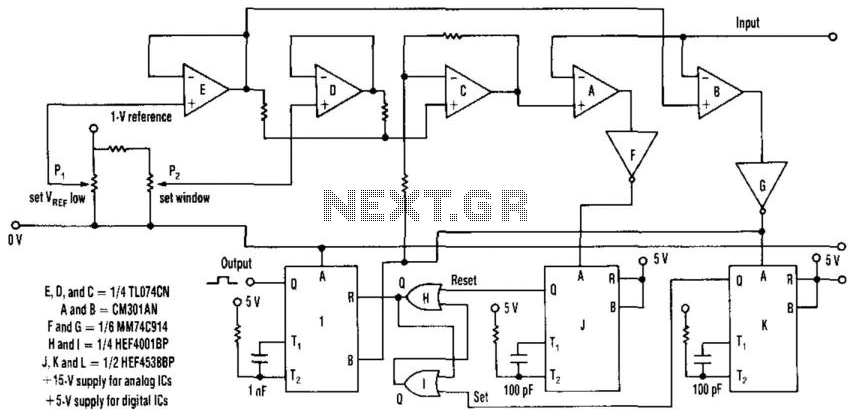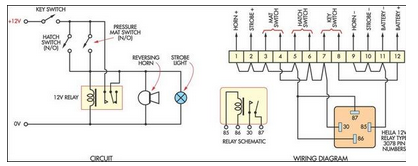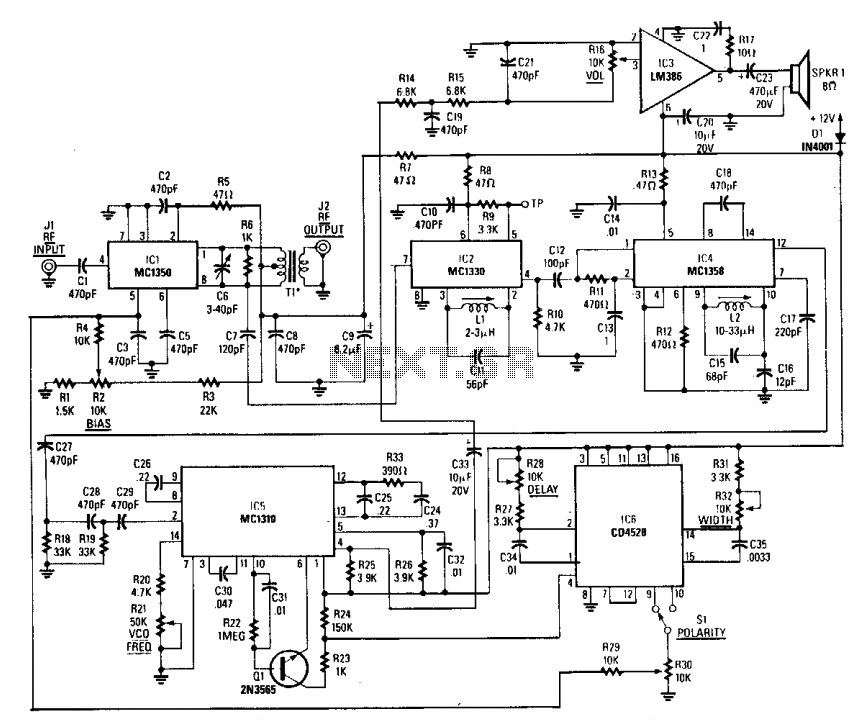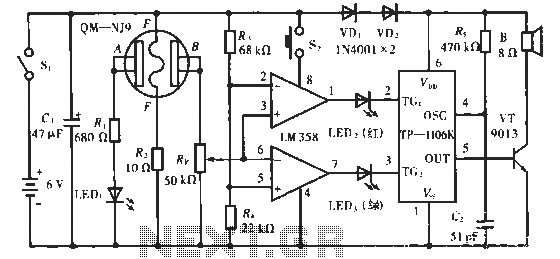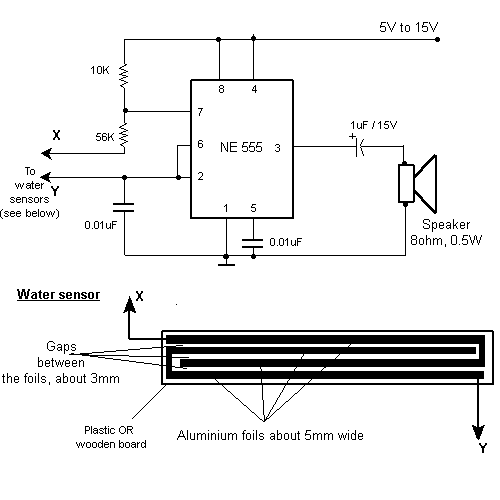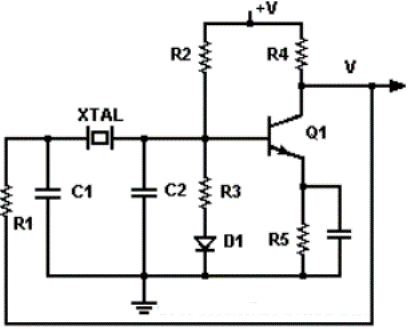
with scr new alarm Window foil burglar

This is a simple yet effective burglar alarm circuit designed to be mounted on windows for detecting break-ins. The circuit employs a fine wire element arranged as a network within the window glass for sensing any breach. Under normal conditions, the base of transistor Q1 is held at ground potential by the wire element, keeping Q1 off and preventing SCR H1 from conducting, which means the horn remains silent. When the wire element is interrupted, the base of Q1 receives a positive potential, turning Q1 on. This activates SCR H1 (TYN 612), causing the horn to sound, and this state is latched by the SCR. The circuit remains active until the original condition is restored or the power supply is turned off.
The burglar alarm circuit described operates on a straightforward principle that leverages the interruption of a fine wire element to trigger an alert system. The wire element acts as a sensing mechanism integrated into the window glass, providing a discreet and effective means of detecting unauthorized access.
When the circuit is in its idle state, the wire element maintains a ground potential at the base of the transistor Q1, which is configured in a common-emitter configuration. The transistor remains in the cutoff region, ensuring that no current flows through the anode of the SCR H1. Consequently, the SCR remains in its off state, and the connected horn remains inactive.
Upon a breach of the wire element, the base of Q1 is exposed to a positive voltage, which transitions the transistor into saturation. This allows current to flow from the collector to the emitter, triggering the gate of SCR H1. The SCR, designed to handle significant current loads, switches to its conducting state, allowing current to flow through the horn circuit and activating the alarm.
The latching behavior of the SCR is crucial for this circuit’s operation. Once triggered, the SCR remains in the on state even if the triggering condition (the broken wire) is removed. This means that the alarm will continue to sound until either the power supply is interrupted or a manual reset mechanism is implemented to turn off the SCR.
In terms of component selection, the TYN 612 SCR is suitable for this application due to its ability to handle high currents and voltages, making it ideal for driving alarm horns or other alerting devices. Additionally, the circuit can be enhanced with additional features such as an LED indicator to show the alarm status, or a reset button to manually disengage the alarm system.
Overall, this burglar alarm circuit represents an effective solution for window security, utilizing simple electronic components to achieve reliable performance. Its design can be adapted for various applications, making it a versatile choice for enhancing security systems.Here is a simple but effective burglar alarm circuit that can be fixed on windows to detect break throughs. The circuit uses a fine wire element fixed as a network through the window glass for sensing the break through.
Normally the base of Q1 is held to ground potential by the wire element. So Q1 will be off and SCR H1 will not be conducting, and horn will be off. When the wire element is broken the base of Q1 will be raised to positive potential, Q1 will be on and so SCR H1 (TYN 612) will be ON making the horn to blow and this condition will be latched by the SCR. The circuit remains ON until the normal condition is restored or the power supply is switched OFF. Disclaimer All files are found using legitimate search engine techniques. This site does not and will not condone hacking into sites to create the links it list. We will and do assume that all links found on the search engines we use are obtained in a legal manner and the webmasters are aware of the links listed on the search engines.
If you find a URL that belongs to you, and you did not realize that it was "open to the public", please use the report button to notify the blogmaster of your request to remove it or it will remove within 24 hours. This is not an invitation for webblog haters to spam with requests to remove content they feel that is objectionable and or unacceptable.
Proof of URL ownership is required. NOTICE: This Blog Has Already Been Reviewed And Accepted By Blogger. com 🔗 External reference
The burglar alarm circuit described operates on a straightforward principle that leverages the interruption of a fine wire element to trigger an alert system. The wire element acts as a sensing mechanism integrated into the window glass, providing a discreet and effective means of detecting unauthorized access.
When the circuit is in its idle state, the wire element maintains a ground potential at the base of the transistor Q1, which is configured in a common-emitter configuration. The transistor remains in the cutoff region, ensuring that no current flows through the anode of the SCR H1. Consequently, the SCR remains in its off state, and the connected horn remains inactive.
Upon a breach of the wire element, the base of Q1 is exposed to a positive voltage, which transitions the transistor into saturation. This allows current to flow from the collector to the emitter, triggering the gate of SCR H1. The SCR, designed to handle significant current loads, switches to its conducting state, allowing current to flow through the horn circuit and activating the alarm.
The latching behavior of the SCR is crucial for this circuit’s operation. Once triggered, the SCR remains in the on state even if the triggering condition (the broken wire) is removed. This means that the alarm will continue to sound until either the power supply is interrupted or a manual reset mechanism is implemented to turn off the SCR.
In terms of component selection, the TYN 612 SCR is suitable for this application due to its ability to handle high currents and voltages, making it ideal for driving alarm horns or other alerting devices. Additionally, the circuit can be enhanced with additional features such as an LED indicator to show the alarm status, or a reset button to manually disengage the alarm system.
Overall, this burglar alarm circuit represents an effective solution for window security, utilizing simple electronic components to achieve reliable performance. Its design can be adapted for various applications, making it a versatile choice for enhancing security systems.Here is a simple but effective burglar alarm circuit that can be fixed on windows to detect break throughs. The circuit uses a fine wire element fixed as a network through the window glass for sensing the break through.
Normally the base of Q1 is held to ground potential by the wire element. So Q1 will be off and SCR H1 will not be conducting, and horn will be off. When the wire element is broken the base of Q1 will be raised to positive potential, Q1 will be on and so SCR H1 (TYN 612) will be ON making the horn to blow and this condition will be latched by the SCR. The circuit remains ON until the normal condition is restored or the power supply is switched OFF. Disclaimer All files are found using legitimate search engine techniques. This site does not and will not condone hacking into sites to create the links it list. We will and do assume that all links found on the search engines we use are obtained in a legal manner and the webmasters are aware of the links listed on the search engines.
If you find a URL that belongs to you, and you did not realize that it was "open to the public", please use the report button to notify the blogmaster of your request to remove it or it will remove within 24 hours. This is not an invitation for webblog haters to spam with requests to remove content they feel that is objectionable and or unacceptable.
Proof of URL ownership is required. NOTICE: This Blog Has Already Been Reviewed And Accepted By Blogger. com 🔗 External reference
